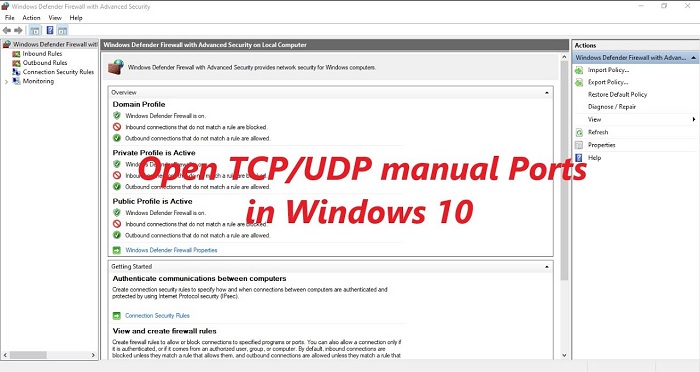able of Contents
- Counting the Number of Default Ports in TCP and UDP
- Examining the Roles of TCP and UDP Default Ports
- Comparing the Default Port Usage in TCP and UDP
- Exploring the Impact of Default Ports on Network Performance
The Transmission Control Protocol (TCP) and the User Datagram Protocol (UDP) are two important components of the Internet Protocol Suite used for communication on the Internet. They are both used to send and receive data, but they differ in the way they do it. In this article, we will discuss the number of default ports that are available for each protocol. We will then look at how these ports are used and what the advantages and disadvantages of using them are.
Unpacking the Details of TCP and UDP Default Ports
Transmission Control Protocol (TCP) and User Datagram Protocol (UDP) are two widely-used transport layer protocols for delivering data across networks. Each of them has a pre-defined set of default ports assigned for certain applications and services. TCP is a connection-oriented protocol, which means it establishes a connection between two nodes before data exchange. It has a default port of 80 that is used for web services and applications such as HTTP, FTP, and SSH. Another common port used by TCP is port 443, which is used for secure web services such as HTTPS, TLS, and SFTP.
UDP is a connectionless protocol, which means it does not require a connection prior to data exchange. It has a default port of 53 that is used for DNS queries and responses. Another common port used by UDP is port 67, which is used for DHCP requests and responses. In summary, TCP has two commonly-used default ports—port 80 and port 443—while UDP has two commonly-used default ports—port 53 and port
1. Knowing which ports are used for which applications and services can help troubleshoot network issues and ensure data is delivered securely and reliably.
Counting the Number of Default Ports in TCP and UDP
The Transmission Control Protocol (TCP) and the User Datagram Protocol (UDP) are two of the most popular protocols used in network communication. TCP and UDP are both categorized as Transport Layer protocols, and they are responsible for providing connection-oriented communication between two hosts.
TCP is a connection-oriented protocol that ensures reliable communication between two hosts by sequentially acknowledging the packets transmitted from one host to another. It also has the ability to re-transmit lost or corrupted packets. TCP has a default port number of
1.
UDP is a connectionless protocol that does not acknowledge the packets it transmits. It is often used in applications that require real-time communication. UDP has a default port number of
2.
In summary, TCP has one default port number (port 80) and UDP has one default port number (port 53).
Examining the Roles of TCP and UDP Default Ports
The Transmission Control Protocol (TCP) and User Datagram Protocol (UDP) are two of the most popular protocols used in network communication today. They both provide reliable and efficient means for exchanging data, but they differ in the way they handle data transmission. In this article, we will examine the roles of TCP and UDP default ports in network communication. TCP is a connection-oriented protocol that requires the two hosts involved in the communication to establish a connection before any data can be exchanged. This connection is maintained through the use of a virtual circuit that is established when the two hosts exchange their TCP port numbers.
The default port for TCP is port 80, and it is used for web traffic. UDP, on the other hand, is a connectionless protocol that does not require the two hosts to establish a connection before exchanging data. Instead, the two hosts simply exchange their UDP port numbers and the data is transferred directly to the recipient. The default port for UDP is port 53, and it is used for DNS queries. In addition to the TCP and UDP default ports, there are many other ports used for various types of network traffic. For example, port 21 is used for FTP (File Transfer Protocol), port 25 is used for SMTP (Simple Mail Transfer Protocol), and port 443 is used for HTTPS (Secure Hypertext Transfer Protocol).
In conclusion, TCP and UDP default ports are essential for efficient network communication. While TCP requires a connection to be established before data can be exchanged, UDP does not. Both protocols have their own default ports, and there are many other ports used for various types of network traffic. By understanding the roles of TCP and UDP default ports, network administrators can better manage their networks and ensure reliable network communication.

Comparing the Default Port Usage in TCP and UDP
The Transmission Control Protocol (TCP) and the User Datagram Protocol (UDP) are two of the most widely used protocols in the Internet protocol suite. They are used to transport data from one computer to another over a network. Both protocols use the same underlying technology but differ in how they transfer data. The default port usage for TCP and UDP differs significantly. The default port for TCP is port 80, while the default port for UDP is port.
1. This is because TCP establishes a connection between two computers and requires a handshake process, which requires port
2. UDP, on the other hand, does not require a connection and can send data without a handshake process, so it uses port
3. Port 80 is used for HTTP, which is used for web browsing, and port 53 is used for Domain Name System (DNS) lookups. TCP is a reliable protocol, which means it will resend data if it is not received correctly, while UDP is an unreliable protocol, which means it does not resend data if it is not received correctly.
In addition, TCP is considered a connection-oriented protocol, while UDP is considered a connectionless protocol. This means that TCP requires a connection between two computers before data can be sent, while UDP does not require a connection and can send data without one. In conclusion, the default port usage in TCP and UDP differs significantly. TCP uses port 80 for establishing a connection between two computers and UDP uses port 53 for sending data without a connection. Knowing the difference between the two can help ensure that data is transmitted correctly and efficiently.
Exploring the Impact of Default Ports on Network Performance
The impact of default ports on network performance can be significant. Default ports are communication endpoints used in computer networking for sending and receiving data. They are typically assigned by the Internet Assigned Numbers Authority (IANA) and are used to facilitate communication between two or more computers. When a default port is used to establish a connection between two computers, it creates a network tunnel through which data can be sent and received. This tunnel can be used to send and receive data for a number of different applications, such as web browsing, email, and other services.
The type of data being sent through the tunnel, as well as the amount of data being sent, can affect the performance of the network. For example, if the default ports are used to send large amounts of data, such as video or audio files, the network may become overloaded and performance may suffer. Also, if the default ports are used to send and receive data in an inefficient manner, such as using an outdated protocol, the network may be slow and unreliable.
In addition, if the default ports are not configured correctly, the network may be vulnerable to attack from malicious actors. Overall, the use of default ports can have a significant impact on the performance of a network. As such, it is important for network administrators to understand the implications of these ports and to ensure that they are configured correctly. It is also important to ensure that the default ports are not used to send or receive data that is not necessary or that is inefficient, as this can lead to degraded network performance.
Conclusion
In conclusion, there are a total of 65,535 TCP and UDP default ports available for use. While the majority of them are assigned for specific services, the remaining are available for custom applications. It is important to note that the range of ports available may vary depending on the operating system in use. Additionally, some port numbers may be reserved for internal communication and can be used without running the risk of a conflict.
